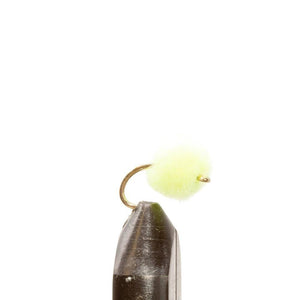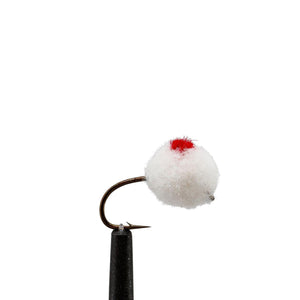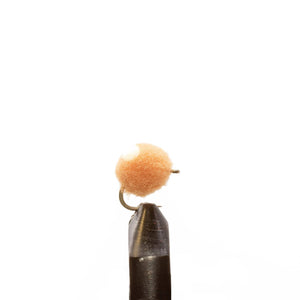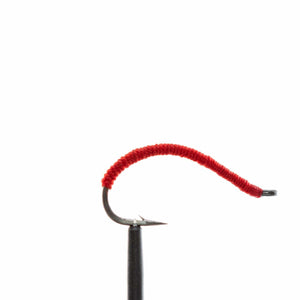The Incredible Egg & Wondrous Worms

As the snow melts and the temperature begins to rise, spring brings an exciting time for fly fishing. During this time, many fish species are gearing up for their spawning season, which means they are actively feeding and looking for food. One of the most effective techniques during this time is using egg and worm patterns.
Eggs are an effective pattern for early spring fishing, particularly for trout, steelhead and salmon. During this time, the fish are in their pre-spawning stage and are actively feeding to build up their energy reserves. The eggs imitate the fish's natural food source, which they will aggressively attack. These flies can be tied in various sizes, and colors, including orange, pink, and chartreuse, which imitate the different stages of a fish's egg development.
When fishing with egg patterns, it's important to present the fly in a natural manner. This can be achieved by using a drift or swing technique. A drift technique involves casting the egg pattern upstream and allowing it to drift naturally with the current, imitating the movement of a drifting egg. A swing technique involves casting the egg pattern across the current and allowing it to swing in the water, mimicking the movement of a drifting egg.
San Juan worms are another popular pattern for early spring fishing, especially in rivers with high water levels. The worm imitates the natural earthworms that get washed into the river during a rainstorm or runoff. The worm is often tied with chenille, which can be dyed in different colors to imitate the different stages of an earthworm's life cycle. These flies can be fished as a dropper behind a larger nymph or dry fly, or they can be fished as the lead fly in a tandem rig.
When fishing with San Juan worms and eggs, it's important to match the hatch and use the correct size and color. You should also vary the retrieve speed and pattern until you find what works best for the fish. A good approach is to fish these flies deep and slow, allowing them to drift naturally in the current.
Here are some tips for fishing with egg and worm patterns in early spring:
-
Match the Hatch – Matching the hatch is always important when fly fishing, but it is especially crucial in early spring. During this time, fish may be feeding on a specific type of food, such as eggs or worms. It's essential to choose egg or San Juan worm patterns that match the natural food source of the fish in the area you are fishing.
-
Presentation – When fishing with egg patterns, presentation is critical. It's important to present the fly in a natural manner, mimicking the movement of a drifting egg in the water. This can be achieved by using a drift or swing technique. A drift technique involves casting the egg pattern upstream and allowing it to drift naturally with the current. A swing technique involves casting the egg pattern across the current and allowing it to swing in the water.
-
Focus on Warm Water – In early spring, the water temperature can vary significantly from one location to another. As such, it's crucial to focus your efforts on areas with warmer water temperatures. These can include shallow flats that are exposed to the sun or slow-moving pools that receive more sunlight.
-
Use a Light Tippet – Fish can be more cautious and selective during the early spring, so it's important to use a light tippet to avoid spooking them. A tippet with a diameter of 5x or 6x is usually sufficient for fishing with egg or San Juan worm patterns.
- Be Patient – Early spring fishing can be challenging, and it may take some time before you find the right spot or retrieve to attract fish. Be patient and persistent, and don't be afraid to switch up your tactics if you aren't getting bites.
Early spring fishing can also bring some challenging weather conditions, so make sure to dress appropriately and bring along some extra layers to stay warm and comfortable.
The key to successful early spring fly fishing is to be adaptable and persistent, as the fish may not always be in the same location or feeding pattern. By matching the hatch, presenting the fly in a natural manner, considering the water temperature, using a light tippet, and being patient, you can increase your chances of a successful fishing experience. As always, good luck and tight lines!
Here are some egg patterns we like:
White Glo Bug/ Red Dot: This egg pattern is highly effective around spawning trout and salmon. The Glo Bug is lightweight and will toss and turn with the water. This innovative fly pattern combines the best of both worlds, featuring a classic white glo bug with a bright red dot that mimics a freshly laid egg.

The Chartreuse Glo Bug is an innovative fly pattern that mimics the appearance of an egg, making it irresistible to fish during spawning season. Expertly crafted with premium materials, this fly boasts a bright chartreuse color and realistic shape that can be used in various water conditions. Its weighted design ensures it sinks quickly and is easy to control.
The Dead Egg Glo Bug is a fly pattern designed to mimic a dead egg or an egg that was not fertilized, making it ideal for targeting fish during spawning season. Crafted with high-quality materials, this fly is both durable and effective, with a weighted design that sinks quickly and is easy to control in fast-moving currents.
Shop All Eggs
Below are three worm patterns we recommend keeping in your fly box.
San Juan Worm Red: This worm imitation represents an aquatic worm which is a prevalant food source for Trout. More than anything, it is just a good attractor pattern that Trout really seem to like.
San Juan Wire Worm Chartreuse: The living worms tend to be of neutral colours however time and experience have demonstrated that Trout frequently find an added attraction to the extra little colouring. Trout simply cannot resist this tempting imitation when it is put before them.
Double Bead "Ron Burgundy" Ultra Worm is a pattern that is an offshoot of the popular bead Ultra Worm. The double bead allows this worm to sink faster. The burgundy color is great for muddy water as the fish see purple as a dark object that stands out better.
Shop All Worms
Related Articles:
- How to Use a San Juan Worm
- JHFLYCO Late Winter Fly Guide
- JHFLYCO Spring Fly Guide
- 8 Spring Fly Fishing Tips for Landing Your Dream Trout
- 7 Tips To Stay Safe While Fly Fishing This Winter
- 20 Essential JHFLYCO Winter Fly Patterns












